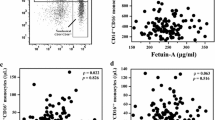Summary
Gliclazide used for the treatment of type 2 diabetes mellitus (T2DM) stimulates insulin secretion and influences peripheral blood monocytes. The roles of gliclazide in peripheral monocytes of newly diagnosed T2DM patients were investigated in this study. A total of 105 newly diagnosed T2DM patients with no history of antihyperglycemic medication were treated with gliclazide-modified release for 16 weeks. The total and differential leukocyte profiles of peripheral blood were measured at baseline and week 16. The peripheral blood monocyte count at week 16 was significantly lower than that at baseline (P=0.019). Peripheral monocytes level at baseline was positively correlated with waist circumference. After gliclazide treatment, the peripheral monocytes were decreased [(320.09±15.13)×106/L vs. (294.19±14.22)×106/L] in non-abdominal obesity group, but increased in abdominal obesity group [(344.36±17.24)×106/L vs. (351.87±16.93)×106/L]. Compared with non-abdominal obese patients, abdominal obese patients showed higher Δmonocytes (P=0.046) and Δacute insulin secretion (P=0.049), but lower ΔHbA1c (P=0.047). There was significantly positive correlation between Δmonocytes and Δacute insulin secretion (P=0.015), which disappeared after adjusting for age, waist circumference and dosage at baseline. In conclusion, waist circumference is correlated with peripheral monocyte change after gliclazide treatment in Chinese newly diagnosed T2DM patients. Peripheral monocytes are decreased in non-abdominal obesity group and increased in abdominal obesity group after gliclazide treatment.
Similar content being viewed by others
References
Hu H, Jiang H, Ren H, et al. AGEs and chronic subclinical inflammation in diabetes: disorders of immune system. Diabetes Metab Res Rev, 2015,31(2):127–137
Tian JY, Yang Y, Cheng Q, et al. Association of WBC count and glucose metabolism among Chinese population aged 40 years and over. Diabetes Res Clin Pract, 2008,82(1):132–138
Ford ES. Leukocyte count, erythrocyte sedimentation rate, and diabetes incidence in a national sample of US adults. Am J Epidemiol, 2002,155(1):57–64
Pertynska-Marczewska M, Kiriakidis S, Wait R, et al. Advanced glycation end products upregulate angiogenic and proinflammatory cytokine production in human monocyte/ macrophages. Cytokine, 2004,28(1):35–47
Shurtz-Swirski R, Sela S, Herskovits AT, et al. Involvement of peripheral polymorphonuclear leukocytes in oxidative stress and inflammation in type 2 diabetic patients. Diabetes Care, 2001,24(1):104–110
Scherberich JE. Proinflammatory blood monocytes: main effector and target cells in systemic and renal disease; background and therapeutic implications. Int J Clin Pharmacol Ther, 2003,41(10):459–464
Xu JM, Shi GP. Emerging role of mast cells and macrophages in cardiovascular and metabolic diseases. Endocr Rev, 2012,33(1):71–108
Xu H, Barnes GT, Yang Q, et al. Chronic inflammation in fat plays a crucial role in the development of obesity-related insulin resistance. J Clin Inves, 2003,112(12):1821–1830
Mamputu JC, Li L, Renier G. Gliclazide inhibits differentiation-associated biologic events in human monocyte-derived macrophages. Metabolism, 2006,55(6):778–785
Alberti KG, Zimmet PZ. Definition, diagnosis and classification of diabetes mellitus and its complications. Part 1: diagnosis and classification of diabetes mellitus provisional report of a WHO consultation. Diabet Med, 1998,15(7):539–553
Li Q, Chen M, Zhang R, et al. KCNJ11 E23K variant is associated with therapeutic effect of sulfonylureas in Chinese type 2 diabetic patients. Clin Exp Pharmacol Physiol, 2014,41(10):748–754
Bao Y, Lu J, Wang C, et al. Optimal waist circumference cutoffs for abdominal obesity in Chinese. Atherosclerosis, 2008,201(2):378–384
Matthews DR, Hosker JP, Rudenski AS, et al. Homeostasis model assessment: insulin resistance and beta-cell function from fasting plasma glucose and insulin concentrations in man. Diabetologia, 1985,28(7):412–419
Kraakman MJ, Murphy AJ, et al. Macrophage polarization in obesity and type 2 diabetes: weighing down our understanding of macrophage function? Front Immunol, 2014,5:470
Drzewoski J, Zurawska-Klis M. Effect of glicalzide modified release on adiponectin, interleukin-6, and tumor necrosis factor-alpha plasma levels in individuals with type 2 diabetes mellitus. Curr Med Res Opin, 2006,22(10):1921–1926
Renier G, Mamputu JC, Serri O. Benefits of gliclazide in the atherosclerotic process: decrease in monocyte adhesion to endothelial cells. Metabolism, 2003,52(8 Suppl 1):13–18
Mamtani M, Kulkarni H, Dyer TD, et al. Waist circumference independently associates with the risk of insulin resistance and type 2 diabetes in mexican american families. PLoS One, 2013,8(3):e59153
Andersson DP, Wahrenberg H, Toft E, et al. Waist circumference to assess reversal of insulin resistance following weight reduction after bariatric surgery: cohort and cross-sectional studies. Int J Obes (Lond), 2014,38(3):483–443
Xu XJ, Gauthier MS, Hess DT, et al. Insulin sensitive and resistant obesity in humans: AMPK activity, oxidative stress, and depot-specific changes in gene expression in adipose tissue. J Lipid Res, 2012,53(4):792–801
Kanda H, Tateya S, Tamori Y, et al. MCP-1 contributes to macrophage infiltration into adipose tissue, insulin resistance, and hepatic steatosis in obesity. J Clin Invest, 2006,116(6):1494–1505
Patel PS, Buras ED, Balasubramanyam A. The role of the immune system in obesity and insulin resistance. J Obes, 2013,2013:616193
Acknowledgments
We thank the individuals who participated in the present study. We gratefully acknowledge the skillful technical support of all the nursing and medical staff at the Shanghai Clinical Center for Diabetes.
Author information
Authors and Affiliations
Corresponding authors
Additional information
Both authors contributed equally to this work.
This work was supported by 973 Program (No. 2011CB504001), the National Natural Science Foundation of China (Nos. 81322010, 81170735 and 81200582), the Drug Innovation Program of the National Science and Technology Project (No. 2011ZX09307-001-02), 863 Program (No. 2012AA02A509), Excellent Young Medical Expert of Shanghai (No. XYQ2011041), Shanghai Talent Development Grant (No. 2012041) and National Young Top Talent Supporting Program.
Rights and permissions
About this article
Cite this article
Li, Q., Yu, Hy., Chen, M. et al. Waist circumference-dependent peripheral monocytes change after gliclazide treatment for Chinese type 2 diabetic patients. J. Huazhong Univ. Sci. Technol. [Med. Sci.] 37, 204–209 (2017). https://doi.org/10.1007/s11596-017-1716-x
Received:
Revised:
Published:
Issue Date:
DOI: https://doi.org/10.1007/s11596-017-1716-x




